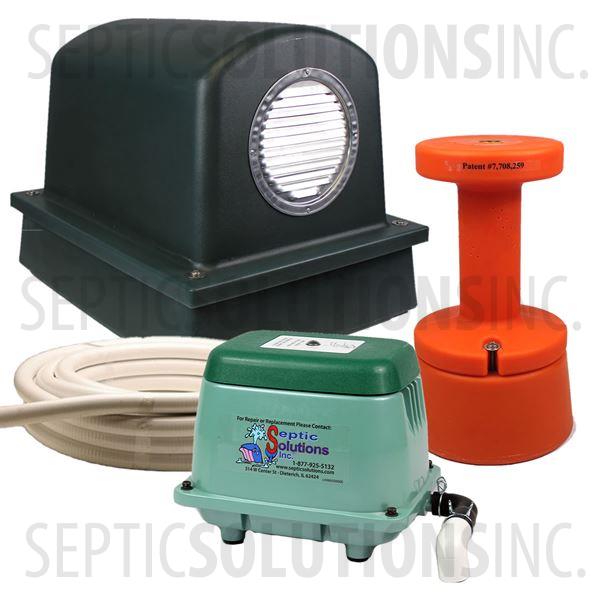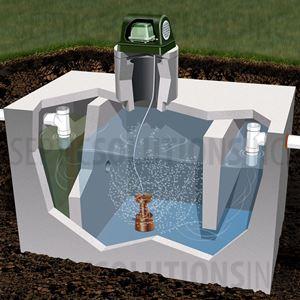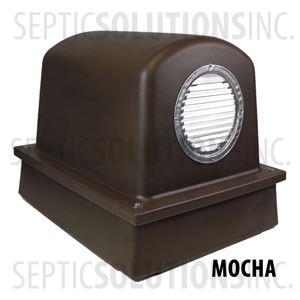
+1-(877)-925-5132 - Toll Free Phone
www.septicsoutions.com - Website
SepAerator Value Package Plus - Septic Tank Aerator



The SepAerator® Value Package Plus includes many of the same components as the Premium Package with one exception, the Air Particle Recirculator. This package is commonly used on multiple compartment septic tanks, multiple tank systems, or if there is no access to install the filtering device.
This package was designed to be installed in a multiple compartment septic tank with a volume ranging from 750 to 2000 gallons and can adequately treat a flow of 300-600 gallons per day. Larger sized systems are available.
In Stock
Item #:SepValuePkgPlus
Manufacturer:Septic Solutions
SepAerator® Value Package Plus Includes:
- High Performance Hiblow Septic Air Pump
- 3.7 cfm, 120VAC, 1.6A, 71 Watts, 36dBA
- Air Pump Housing and Platform
- Patented Wonderfuser™ Diffuser Assembly
- 10 feet of Spa-Flex Heavy Duty Air Line
- Other Miscellaneous Installation Components
- Installation and Maintenance Manual
Applications for the SepAerator® Value Package Plus
- Designed To Convert Existing Septic Tank Into An Advanced Aerobic Treatment System
- Eliminates Clogging Biomat In Drainfields And Other Secondary Treatment Systems
- Designed To Be Installed In Septic Tanks With Capacity Ranging From 750 Gallons up to 2000 Gallons
- Designed To Be Used In Multiple Compartment Septic Tanks or Multiple Tank Systems
- Developed By Experts With Over 25 Years In The Aerobic Wastewater Treatment Industry
Additional Detailed Information
- How the SepAerator® System Works
- The SepAerator® Aerobic Process
- The Wonderfuser™ Diffuser Assembly
- Pick the Right SepAerator® Package For Your Application!
- Frequently Asked Questions about the SepAerator®
- SepAerator® Sampling Results
- SepAerator® Success Stories
SEPAERATOR® VALUE PACKAGE PLUS DETAILS
Hiblow Air Pump
The SepAerator™ uses only top quality air pumps that are designed and proven to run trouble free for many years. The Hiblow air pumps have proven to be high quality and high performance septic air pumps. The Hiblow air pump used on the SepAerator™ Premium package has an output of 3.7 c.f.m. and is effective at treating 500 gallons per day of wastewater or up to a 2000 gallon septic tank.
This air pump will use approximately $4 to $8 per month to operate. The Hiblow air pumps were designed to run continously and our system works best when operated that way. The average life of the diaphragms in the air pump is 5 to 7 years. The diaphragms are a replaceable part, and Septic Solutions® carries a full line of Hiblow Replacement Parts. If you decide to repair your unit when the diaphragms fail, a pump will last you around 10 to 12 years.
Patented Wonderfuser™ Assembly
The Wonderfuser diffuser assembly is a unique design offered only in the SepAerator™ packages from Septic Solutions®. The Wonderfuser is maintenance free and very effective at not only transfering oxygen into the wastewater, but also breaking down large solids into tiny particles for easier digestion.
The Wonderfuser will be lowered and sat on the bottom of your septic tank on the inlet side. The base of the diffuser assembly weighs 13 pounds to ensure it will sit securely on the bottom. The diffuser is self-positioning, meaning you do not have to mount it in any way, nor do you have to worry about it falling over, as the top of the diffuser is buoyant and will always end up in the upright position.
The SepAerator™ Wonderfuser introduces oxygen some 10 inches off the bottom of a septic tank through a series of 48 orifices angled downward at approximately 35 degrees from top to bottom. When air is diffused in water and bubbles are created, the air bubbles want to travel straight up. The Wonderfuser has a deflection area 15 inches from the bottom that causes all rising air bubbles to be deflected outward 360 degrees around the diffuser. This allows the oxygen to stay in the tank much longer than other systems. Secondly the deflector creates a rolling action in the tank. This rolling action provides a very important function that causes the combined air and water movement to act somewhat like an oversized household blender exploding large solids into tiny particles for easier digestion.
Unique to the SepAerator™ Wonderfuser, by utilizing this deflected rolling action most solids that come into the tank are broken down into very small particles within 30 seconds. When those solids are rapidly broken into small particles that are continually moving inside the tank, aerobic bacteria generated by sufficient oxygen being introduced inside the tank, can quickly and easily attach themselves to those small particles. Much smaller and moving particles can be found and devoured by these aerobic bacteria very quickly resulting in a much higher quality of effluent.
Air Pump Housing and Platform
The SepAerator™ Value Package includes our durable and attractive Air Pump Housing and Platform combination. These from manufacturered from roto-molded HDPE plastic designed to last many years sitting outside in various weather conditions. These products will withstand the strong Ultra-violet rays of the sun, extreme hot or cold weather, as well as keep your air pump out of rain or snow.
At both ends of the Housing are eight inch aluminum vents for adequate pump ventilation. One of the most important things anyone can do to protect their investment in a new air pump is to make sure that air pump does not run too hot. Inadequate ventilation can and will cause pre-mature failure of any air pump.
The SepAerator™ Housing and Platform was specifically designed and built for the sole purpose of protecting and ventilating our air pumps. The Housing has curved edges and a rolling curved top, which adds significantly to its strength.
Heavy Duty Spa-Flex Airline
The spa-flex air line is made up of a very high grade material that is very strong and flexible. Its flexibility allows for easy installation in even the most difficult of circumstances. Simply screw the threaded brass adapter attached to the air line into the fitting in the top of the diffuser. Lower the diffuser into the tank using the spa-flex and even swing it over into position if necessary. Curve the line up through the opening and out the side and then up and into the bottom of the housing where the other end hooks to the air pump. It cannot be much easier than that. This spa-flex can be glued to ½ schedule 40 pvc pipe if you want to extend the pump to a remote location. It is extremely tough and durable ensuring that it will deliver air from the pump to the diffuser trouble free for many years to come.
Installation and Maintenance Manual
A complete Owners’ manual comes with each SepAerator™ package providing all the information necessary to not only easily install the SepAerator™ but also plenty of information on the proper operation of it after installation as well. When you purchase a SepAerator™ there is an abundance of information that comes with it, and all the technical support you might need to answer any and all your questions both during and after installation at 1-877-925-5132. Don’t hesitate to call as it is always our pleasure to answer any question you might have to ensure proper installation of this extremely effective product.
HOW IT WORKS
How a Standard Septic System Functions
When a stool in the home is flushed the wastewater drops into a drainpipe that carries it underground to a septic tank. The purpose of the septic tank is to allow anaerobic bacteria (bacteria that grows without oxygen) to break the waste down over time. The septic tank has both an inlet baffle and outlet baffle necessary to keep waste from entering the tank and floating directly across the top of the septic tank and discharging to the secondary treatment system (drain field, sand filter, mound system, drip system, cesspool, dry well, etc.). Without these baffles the drain field would quickly fill up with these solids causing drain field failure. The septic tank normally discharges 70 to 80% raw sewage to the drain field where this raw sewage is processed by passing through a build-up of substance called biomat.
What is Biomat?
Biomat is a layer of bacteria that forms in the soil in the secondary treatment system. This biomat is very important in processing the raw sewage that generally discharges from the septic tank. It’s purpose is to process the many small waste particles and pathogens that make up the septic tank discharge before soil absorption can take place. Without this process, inadequately treated effluent can contaminate groundwater, which can end up in wells, streams, ponds or even the ground surface. Should this happen the potential for the family pet or even the children to come in contact with septic tank effluent containing disease carrying pathogens is dangerously increased.
Once the septic tank effluent is discharged to either a drain field or seepage bed the biomat that forms will effectively reduce the waste particles and pathogens to an acceptable level before it can move further into the surrounding soils. Inadequate treatment of any septic tank discharge should be considered unacceptable and remediated immediately
The Issues Caused By Biomat
As the biomat continues to grow over the years, the effluent discharging from the septic tank cannot penetrate through it causing the effluent level inside the drain field trenches to rise where it will absorb through the sides of these trenches. After a period of time the sides of these trenches will begin to clog. Once the bottom and the sides of these trenches are clogged with biomat, the effluent will either begin to back up into the septic tank or surface in the yard above the drain field. Most septic tanks have approximately 4 inches of fall between the inlet of the septic tank and the outlet. If the effluent level raises 4 inches in the septic tank because it can no longer enter into the absorption field then it begins to back up the inlet pipe. Once this happens the drains in the home will become very sluggish as there is nowhere for the effluent to go.
Biomats purposely restrict the flow of effluent to the soils allowing them time to filter out the pathogens and viruses. Eventually the hydraulic loading rate (gallons of water being drained from the home) will exceed the soil absorption capacity of the drain field. Once this happens the septic tank effluent will either back up into the home or discharge to the ground surface causing ponding. This is the number one cause of drain field or secondary treatment system failure, especially in systems that are over 10 years of age. Signs that a system is failing because of biomat buildup include but are not limited to: water or sludge surfacing at the drain field, high water levels in the septic tank or distribution box, slow flowing and gurgling drains and toilets. The SepAerator™ is designed to reverse these symptoms, read more below.
How The SepAerator® Can Save Your System
Anaerobic bacteria and the waste generated by these anaerobic bacteria processing the 70 to 80% organic matter discharged from the septic tank are what make up biomat. When you convert your septic tank to the aerobic process using the SepAerator®, the septic tank becomes a wastewater treatment plant and will discharge around 95% clear odorless water. By removing this organic material waste from the effluent, you eliminate the food source that allows the biomat to thrive and survive in the drain field. The anaerobic bacteria will starve and die, the existing biomat will break down and dissolve, and no new biomat will form in the future, making the SepAerator® a complete and permanent fix to your drain field's biomat problem.
Once the SepAerator® is added to an existing septic tank the dynamic of how a septic tank works is dramatically changed. The SepAerator® will introduce large amounts of oxygen inside the septic tank that will rapidly proliferate the growth of aerobic bacteria inside the tank. Aerobic bacteria are much more effective at processing waste and will thrive under the conditions generated by the SepAerator®. Rather than discharging raw sewage into the drain field, seepage bed, sand filter, mound system, cesspool, or whatever type of secondary treatment system you might have the waste is processed inside the septic tank. The SepAerator® has been tested and proven to discharge approximately 95% clear and odorless water to the secondary treatment system. When the waste is processed inside the septic tank with clear water discharging to the secondary treatment system the biomat loses it's food source and will quickly die. Since biomat needs anaerobic bacteria (bacteria that grows without oxygen) to form, this biomat that has been growing in the secondary treatment system for many years, quickly begins to break-up.
This SepAerator® generated clean effluent, mixed with large amounts of aerobic bacteria entering into the secondary treatment system will cause the biomat to disappear allowing the clean effluent to easily penetrate into the soils once again. Since the aerobic bacteria are very effective at reducing disease causing pathogens the rejuvenation and transformation of the septic system is complete.